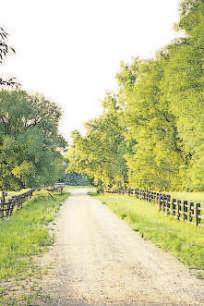Local lawmaker leads effort to stem hospital spending, insurance costs
Page 2

Humans aren’t the only ones out there tapping Vermont’s maples
Page 10

March 20, 2025

Local lawmaker leads effort to stem hospital spending, insurance costs
Page 2

Humans aren’t the only ones out there tapping Vermont’s maples
Page 10

March 20, 2025
BRIANA BRADY STAFF WRITER
A Hinesburg mobile home park went without running water for a week earlier this month while its management company tried to fix a leak in one of the park’s water pipes.
Sunset Lake, off Richmond Road, is a resident-owned cooperative with 55 individual homes. Residents there collectively own the park and govern themselves through a co-op board. The board also contracts with Majestic Property Management to run day-today operations. While Sunset Lake is connected to the town water supply, the co-op owns and is responsible for the pipes on their own property.
On Tuesday, Mar. 4, the Hinesburg Water Department informed
the co-op board and the management company that an excessive amount of water was entering the park, indicating that there might be a leak somewhere on the property.
According to Majestic Property Management owner Bob Lake — who, along with another employee, also oversees four other cooperative mobile home parks in the state — the amount of water entering the park from the town main was about twice the amount expected for the number of people living there. In response, a member of the co-op board asked the town to turn off the water to the park while they tried to locate and repair the leak.
On March 4, the management
See SUNSET LAKE on page 12

LIBERTY DARR STAFF WRITER
With the legislative session in full swing, Chittenden Southeast senators Kesha Ram Hinsdale, Thomas Chittenden and Virginia “Ginny” Lyons talked with dozens of constituents this weekend to

discuss all things education reform, property taxes and healthcare.
The Legislature has some mighty tasks still at hand with a little over two months left of the session, including a massive plan proposed by Republican Gov. Phil Scott to reform the way that Vermont funds and ultimately
plans for education. And last week the Senate voted 22-8 to confirm Zoie Saunders as the state’s secretary of education in the throes of the education reform talk. Saunders was appointed by Gov. Scott on an interim basis after the Senate rejected her approval 19-9 last April.

“There are not many commissioners or secretaries who have faced this much scrutiny and have been considered so much of a litmus test on the future of policy in that area,” Ram Hinsdale, D-Shelburne, said. “Some senators got up and said they’ve never heard from constituents about an appointment of the governor until now.”
Ram Hinsdale, Senate Majority Leader and a member of the Senate Committee on Education, was the only one of the three to vote against Saunders’ appoint-

BRIANA BRADY STAFF WRITER
The Senate Committee on Health and Welfare moved a bill on Friday that aims to regulate hospital spending and, through that, bring down insurance premiums.
The bill aligns broadly with recommendations made in a report from the Green Mountain Care Board in December that outline the implementation of reference-based pricing, a model that would use Medicare rates as a baseline for the cost of hospital services.
budgets pay for staff compensation. Lyons is the chair of the Senate health committee.
“The contracts between hospitals and insurers and payers are in a black box.”
While the bill is focused on the hospital infrastructure in Vermont, the stated goal of bringing down premiums speaks to the budgeting crunch that local municipalities and school districts have been under due to rising healthcare costs.
— Sen. Ginny Lyons
At Champlain Valley School District’s annual legislative breakfast last week, Chittenden Southeast Sen. Virginia “Ginny” Lyons, D-Williston, brought up the bill as a part of the solution for rising budget costs — the bulk of municipal and school
According to Gary Marckres, the chief operating officer for the Champlain Valley School District, the district’s cost for a family plan has more than doubled from $17,000 to $40,000 over the last few years. Although the district achieved an overall budget increase of less than one percent for next fiscal year, it will be eliminating nearly 40 staff positions. Similarly, about 75 percent of the increase in South Burlington School District’s FY26 budget expenditures were due to an 11 percent increase in their health care costs. And in Shelburne, the selectboard considered asking employees to pay into their health care benefits for the first time to balance the almost 12 percent raise in costs they were experiencing.
According to the Green Mountain Care Board report from December, reference-based pricing could ease these financial burdens by “lowering prices paid on services, thereby reducing the need to increase taxes or reduce

benefits to ensure the future solvency of the funds.”
As written in the bill, this would involve the state regulating some of what has been a private process: negotiations between hospitals and insurance companies.
“The contracts between hospitals and insurers and payers are in a black box. They’re not transparent. We don’t see them. So first of all, reference-based pricing is a way of saying, ‘This is how much you get paid at this level with respect to Medicare,’” Lyons said in an interview Friday.
The proposed bill sets up a system in which the Green Mountain Care Board would review the budgets and circumstances of each hospital, including what services they offer, staff compensation and the population they serve. Based on the needs of each hospital, the board would then regulate what they’re allowed to charge for services, with Medi-
care rates as a benchmark.
According to Lyons, this might mean 200 percent of the Medicare rates, or even 250 or 300 percent, depending on the hospital.
“We know that hospitals and providers can make out fairly well with Medicare payment, but it’s still not enough to support the services that they offer or the people who work for them, and particular hospitals need a little bit more money,” Lyons said.
By capping rates, Lyons said, commercial insurers would end up paying less for services, which would bring down premium costs. The text of the bill states, “The Board, in collaboration with the Department of Financial Regulation, shall monitor the implementation of reference-based pricing to ensure that any decreased prices paid to hospitals result in commensurate decreases in health insurance premiums.”
According to Lyons, the bill continues to work toward overall healthcare system reform in Vermont. In addition to reference-based pricing, it would also institute a state-wide medical information sharing system and a state-wide healthcare delivery plan as well as creating a healthcare delivery advisory committee.
“Reference-based pricing is just one step in the direction that we’re going to get to global budgets,” Lyons said.
Global hospital budgets would eliminate a fee-for-service system with insurers in favor of payments from Medicare, Medicaid, and participating commercial payers in line with their budget. The proposed bill would see global budgets introduced by 2030.
Whether, if adopted and implemented, the bill will affect next year’s municipal and school budgets, remains to be seen.


















continued from page 1
ment last week.
“I think it’s really critical for us to all remember that her first job is to run the agency of education and to bring up our literacy test results and help our school districts share resources,” she said. “We are hearing that that’s simply not happening.”
Lyons, D-Williston, is the longest serving member of the Legislature among the three and currently chairs the Senate Committee on Health and Welfare. She said she voted in support of Saunders mostly after listening on the floor to presentations about her credentials and the work she has done in public schools in Florida before coming to Vermont.
“I think I listened to my colleagues on the Senate floor, one of whom is the chair of Finance, and she was very positive about her working relationship with Secretary Saunders,” Lyons said. “She needs to do the work, and she needs to demonstrate to us that we can move forward in a way that doesn’t harm our school systems, doesn’t harm our teachers and, most importantly, promotes our children.”
“Their
Chittenden, D-South Burlington and vice chair of the Senate Committee on Finance, also voted to confirm Saunders.
its schools, and we have to do this right.”
Ram Hinsdale said the education committee is working on an alternative proposal that also utilizes a foundation formula, although one set higher than the base outlined in Scott’s proposal.
“Their foundation formula had a lot of holes in it, not a lot of money for support staff, for food service staff, for extracurriculars, for a lot of the things that students rely on,” she said.
Healthcare costs play a major component in the state’s growing. For the South Burlington school district alone, the district’s 7 percent spending increase next year is largely indicative of a roughly 11 percent increase in state-mandated district contributions to employee health benefit programs. The district is spending $900,000 more in healthcare than it was last year.
foundation formula had a lot of holes in it.”
— Sen. Kesha Ram Hinsdale
“After reviewing her confirmation hearing yesterday in our newly constituted Senate education committee, I do now have the impression that Secretary Saunders has done her homework,” he wrote earlier this month. “And the last year of her service in this role (as contentious as that path has been) is now experience relevant to the task at hand.”
But their votes to confirm Saunders might not translate to votes in support of the current education reform proposal. The plan, unveiled by Saunders earlier this year, looks to dissolve the 119 school districts spread across the state down to just five regional districts: Southwest Vermont, Southeast Vermont, Winooski Valley, Northeast Kingdom and Champlain Valley. Each district would have roughly 10,00015,000 students, except for Champlain Valley, which would have closer to 34,000.
The proposal would also shift the way education is funded in Vermont to a foundation formula, currently used in several states across the country, by fiscal year 2028. The funding formula, which assumes a base per-pupil spending number for each district, would ultimately seismically shift more power to the state when it comes to how much schools spend each year.
While Chittenden agrees that reducing the number of districts within the state would create better economies of scale, having just five districts within the state is a non-starter for him.
He said he sees value in a foundation formula, but he is pushing back on the Governor’s time frame for implementation. He said he sees it taking between three and 10 years, with savings achieved through a gradual implementation plan.
“We can’t do this too fast, because if you do this, the harder and faster you push things, the more friction you create,” he said. “And Vermont cares about its kids and
Lyons said there is no doubt the state is in the middle of a health care crisis, and her committee introduced a bill last week aimed at remedying some of those cost constraints (see related story pg. 2).
“If we could align everyone together and have Medicare for all, that would be the end of conversation,” she said.
“We would be where we need to be. But it isn’t, especially given what the federal government is doing. That’s not an easy answer right now, but I continue to work with my committee to align as much as we can so we have something that mirrors what I know folks would think is best, and that’s Medicare for all.”
When thinking about property taxes, Lyons said the governor has indicated that he would like to invest close to $80 million in reserve funds to reduce property taxes this year, something the Senate Committee on Appropriations, which she is also a member of, will be looking at in the coming months.
Senators also voiced support for raising some revenues in the state through other means like taxing second homes. Ram Hinsdale noted that nearly 20 percent of the state’s entire housing stock consists of second homes, and Vermont is one of two states — Maine is the other — with the highest per capita number of second homes in the country.
“We have a lot of second home parcels which are underutilized roofs that we need in this state,” Chittenden said. “I think taxation policy that makes that more expensive to have a roof that’s not being used all year long for people wanting to contribute to Vermont’s economy is rational to me.”
While Senators focused on issues directly pertaining to Vermonters, the entire Legislature is also up against a brand-new federal administration that has wreaked some amount of havoc for state leaders in recent weeks with talks of federal funding cuts.
“I hate to end on this note, but I think next year is going to be a year of austerity,” Chittenden said. “We have a Republican governor that’s hesitant to approve new revenues, and it’s going to make the budgeting process next year, I think, very, very painful. We’re going to sharpen our pencils, and every dollar has a constituency.” TOWN HALL





DEBORAH J. BENOIT
UVM EXTENSION
Winter weather may be on the wane, but it will still be a while before we can get outdoors and work in the soil. Even so, there’s no reason not to enjoy fresh, homegrown herbs.
Herbs grown indoors don’t care what the temperature is outside,
whether there’s rain or snow or what season it is. Your indoor herb garden can be a pot of basil on a sunny windowsill or a collection of your favorite herbs grown under lights.
What herbs do you want to grow? Oregano (Origanum vulgare)? Sage (Salvia officinalis)? Basil (Ocimum basilicum)? Consider those you use most.
Total incidents: 33 Traffic Stops: 15
Mar. 4 at 11:11 a.m., an officer responded to a two-car motor vehicle crash on Route 116.
Mar. 4 at 6:42 p.m., an officer responded to Kinney Drugs for a report of shoplifting. Cody Martin, 28, of Brattleboro, was cited for retail theft.
Mar. 5 at 7:53 a.m., police investigated a 911 hangup on Hillview Terrace.
Mar. 5 at 5:27 p.m., an officer assisted first responders with a medical emergency on Kaileys Way.
Mar. 6 at 5:02 p.m., police investigated an alarm acti-
vation on Weed Road.
Mar. 7 at 11:58 a.m., an officer responded to a single car motor vehicle crash on Route 116.
Mar. 10 at 4:02 p.m. police assisted a citizen with a lockout.
Mar. 10 at 5:51 p.m., police conducted a welfare check on Hollow Road.
Mar. 10 at 8:03 p.m., an officer assisted first responders with a medical emergency on Ballard’s Corner Road.
Note: Charges filed by police are subject to review by the Chittenden County State’s Attorney office and can be amended or dropped.
Serving the community of Charlotte & Hinesburg A publication of Vermont Community Newspaper Group LLC thecitizenvt.com
Advertising Wendy Ewing wendy@shelburnenews.com (802) 238-4980
Advertising Director Judy Kearns judy@otherpapersbvt.com (802) 734-2928
Editor Tommy Gardner tommy@stowereporter.com (802) 253-2101 x25
Staff Writers
Aaron Calvin Liberty Darr
Patrick Bilow Briana Brady
Production/Design
Stephanie Manning stephanie@shelburnenews.com
Kristen Braley kristen@stowereporter.com
General Manager Katerina Werth katerina@stowereporter.com
Billing inquiries Leslie Lafountain leslie@stowereporter.com (802) 253-2101
Advertising submission deadline: Friday at 5 p.m. advertising@thecitizenvt.com classifieds@thecitizenvt.com
Editorial submission deadline: Friday at 12 p.m. news@thecitizenvt.com
Calendar submission deadline: Friday at 12 p.m. news@thecitizenvt.com
Contact: PO Box 489 Stowe, VT 05672 (802) 253-2101
Perennial herbs such as sage, oregano or thyme (Thymus vulgaris) can live for years and can be grown indoors or outside in your garden. Tender perennials such as rosemary (Salvia Rosmarinus, formerly Rosemarinus officinalis), can be grown indoors year-round or moved outside during warm weather. Annual herbs such as basil or biennials like parsley (Petroselinum crispum) will need to be replaced each year.
You could even grow catnip (Nepeta cataria) for your feline friends. It and other herbs can be used to brew a relaxing cup of tea. This member of the mint family can be grown in a sunny window in a hanging basket to keep it out of kitty’s reach.
Once you’ve decided what herbs you want to grow, decide how you’ll meet their basic needs.
Most herbs need plenty of light. Do you have a window that receives direct sun for six to eight hours a day? If not, grow lights can help provide the light needed for healthy, productive plants.
If you’re relying on a sunny window, turn the pot every few days to prevent one-sided growth. Be sure to check the watering and fertilizing needs of individual herbs. Some will grow best if you keep the soil slightly moist, while others do better if you allow the soil to dry between watering. Avoid overwatering.
If the air in your home is dry, your indoor herb garden may need additional humidity. If you’re only growing a few herbs, mist the plants regularly. Alternatively, multiple plants can be placed on a layer of pebbles in a shallow tray filled with water. Keep the water
below the top of the pebbles. As the water evaporates, it will raise the humidity around the plants. Purchasing plants can provide instant satisfaction, but starting from seed will allow you a wider variety of choices. If you grow herbs from seed, you’ll need a container and potting soil. Follow recommendations for planting on the seed packet and cover the container with a plastic bag to increase humidity until the seeds sprout.
If you have the room, a plant stand can provide a convenient home for a variety of herbs. If your available space is limited, consider a tabletop grow light to create a kitchen counter herb garden. What could be handier than fresh herbs See
The Vermont House of Representatives voted last week to outlaw the use of toxic perfluoroalkyl and polyfluoroalkyl substances (PFAS) in dental floss, cleaning products, and fluorine-treated containers.
According to the Vermont Department of Health, PFAS exposure can lead to reproductive and developmental disorders, decreased antibody response to vaccines, pregnancy-induced hypertension and preeclampsia, certain types of cancer, and more.
The bill (H.238), given initial approval by the House in a voice vote, builds on earlier legislation adopted in Vermont that addressed PFAS in personal care products, menstrual products, textiles, cookware, rugs and carpets, artificial turf, ski wax and more.
“This law will be another important step toward protecting Vermonters and our environment from exposure to toxic PFAS,” Anna Seuberling, environmental health advocate with the Vermont
Public Interest Research Group, said. “In fact, it’s hard to imagine a more direct path of exposure than using a string coated with PFAS to clean your teeth every day.” In addition to adding more products to the list of those that must soon be free from intentionally added PFAS, the legislation strengthens the definition of what it means for the chemical to be






Guest Perspective
Tanya Marshall
As the days are getting longer and snow is melting, it is fitting that this is Sunshine Week, an annual celebration of government records and information as the cornerstone of government accountability and transparency.
A government “of the people, by the people, and for the people,” as President Abraham Lincoln famously stated in his Gettysburg address, means people must have access to authentic and reliable records and information. Without this, we’re in the dark.
As we face an increasingly complex landscape of disinformation and misinformation, access to authentic, reliable and trustworthy government records and information is more important than ever.
Sunshine Week coincides with a poignant time in our history. It is alarming that our fundamental rights as Americans are currently under threat from an unprecedented dismantling of the federal agencies and unauthorized destruction of federal records and information. Both are critical for ensuring government accountability and transparency, fiduciary responsibility to taxpayers, and the public’s right to know.
The effectiveness of all government programs and services relies on authentic and reliable information. Further, the public’s trust in these programs and services relies on transparency, accountability and civic engagement.
Yet, authentic and reliable records and information are being removed from federal websites, despite being an efficient and cost-effective way to provide publicly available information
and actively engage Americans in the federal programs and services they rely on.
Federal civil servants responsible for the management, technologies and use of federal records and information are being fired or have “voluntarily” resigned or retired. Those recently affected include employees at the National Archives and Records Administration, United States Digital Service, 18F (a digital services team within the General Services Administration) and key federal agencies dedicated to data collection and research. All told, the recent and ongoing loss of institutional and expert knowledge is staggering.
For Sunshine Week 2025, it is crucial to shed light on Vermont’s laws for a transparent and open government. The State of Vermont’s commitment to manage and safeguard its local and state government records and information, especially from unauthorized destruction, was established by state law in 1937.
Following the Watergate scandal of 1972 and subsequent Congressional action to further ensure government accountability and transparency, while also balancing individual rights to personal privacy, state legislatures —including the Vermont General Assembly — shored up state laws to require the same.
Today, government accountability and transparency are governed by what is called the Vermont Public Records Act (1 V.S.A. §§ 315 – 320) and its importance cannot be overstated: access to authentic and reliable government records and information is a fundamental right.
The secretary of state’s office, through the Vermont State Archives and Records Adminis-
tration, fulfills a relatively simple, yet essential, role in the Vermont Public Records Act. The Vermont State Archives and Records Administration is charged with supporting Vermont government in systematically managing its records and information “to provide ready access to vital information, to promote the efficient and economical operation of government, and to preserve their legal, administrative, and informational value.” (1 V.S.A. § 317a). The archives, records and information professionals at the Vermont State Archives and Records Administration rise to this challenge without fanfare.
The baseline it sets for Vermont public agencies is compliance with all six parts of the Vermont Public Records Act — policy, access, exemptions, management, procedure, and enforcement — and with the specific laws and rules that govern each individual agency’s records and information.
This work is done in collaboration with managers, technologists, legal counsel and other agency stakeholders. The outcomes are effective policies and procedures for managing and safeguarding Vermont records and information and publicly available documentation of what types of records and information are created or received by each public agency.
Why is this important? Full transparency and accountability of what records and information are created or received and the requirements relating to their management are critically important, especially for legal certainty of their authenticity, reliability and trustworthiness. Government programs and services depend on them and the public does too.
Rep. Phil Pouech
Last week, I highlighted one of the critical issues presently being worked on in our House committees, education. This week: an update on House energy and transportation committees, and the Affordable Heat Act.
Our committees working on energy and environmental issues are building on existing policies around climate change. Climate action is a bread-and-butter, household budget, pocketbook priority. Climate resilience means more than protecting Vermonters
We, as a nation, stand to suffer profoundly if our nation’s “freedom of information,” “public records,” and “right to know” laws falter for any American. The secretary of state’s office is doing, and will continue to do, everything in its power to ensure that the public’s access to authentic, reliable and trustworthy government records and information is neither disrupted nor prevent-
ed. This includes preserving Vermont’s rights to a transparent and open federal government as well.
Tanya Marshall is the Vermont State Archivist and chief records officer and director of the Vermont State Archives and Records Administration, a division of the Vermont Secretary of State.
from severe storms and floods — it means helping them to navigate a disruptive energy transition.
Fossil fuels are not only dirty, but they are also unregulated and extremely price volatile. Fossil fuels are in a global market and subject to fluctuating supply and

































Congressional delegation gets high climate marks
To the Editor:
For nearly 60 years, the League of Conservation Voters has published a “National Environmental Scorecard” to determine which members of Congress are working to protect our air and water, to build a clean energy future, and to ensure our democracy. Here in Vermont, we are fortunate that our Congressional delegation has once again earned top marks.
Recently released, the LCV scorecard for 2024 shows Sen. Bernie Sanders (I) at 88 percent (91 percent lifetime); Sen. Peter Welch (D) at 100 percent (95 percent lifetime); and Rep. Becca Balint (D) at 100 percent (99 percent lifetime).
As a member of the board of directors for Vermont Conservation Voters, the state affiliate of the League of Conservation Voters, I am immensely proud and grateful for Vermont’s Congressional leadership and its unwavering commitment to standing strong against big polluters and their attacks on our
continued from page 5
demand, extreme weather, and geopolitical events. For example, when Russia invaded Ukraine, the price of heating fuel shot up by $2 a gallon, which impacted many Vermont families.
When we help Vermonters to move from fossil fuels to efficient electricity, they will have more stable costs because Vermont regulates electric rates. We have the lowest electricity prices in New England and our electric grid is over 90 percent renewable.
Climate action means helping Vermonters convert to lowercost electric and plug-in hybrid vehicles by expanding electric vehicle charging infrastructure so these lower cost vehicles can be used by everyone, including those who live in apartments or condominiums.
We must continue to support Vermonters to weatherizing drafty homes, install cold climate heat pumps or utilizing heat-pump hot-water heaters. If we don’t move forward to a clean energy future, Vermont will fall behind.
A lot of misinformation surrounded the Legislature’s work on energy and climate last year, especially in regard to the Affordable Heat Act and its proposed clean heat standard. For example, the Public Utility Commission’s
public lands and waterways.
House Republicans in Congress continue to embrace chaos and espouse horrific positions, while here in Vermont, we’ve seen recent attempts by some to roll back the landmark climate progress we’ve achieved. So, it’s heartening to see Vermont’s leaders at the federal level working hard every day to stand up for the health and safety of our environment and to vote for clean energy investments that will save Vermonters’ money in the long run.
We all know that Vermont is facing an immense affordability crisis, so the quicker we can move away from high-cost, price-volatile fossil fuels to lower-cost, more price-stable energy, the better off we will be. By investing in renewable energy initiatives, promoting smart growth housing, safeguarding natural resources, and strengthening our resilience to climate change, we will create a sustainable future for generations to come.
Katherine Crawley Stowe
Jan. 15 report on implementation confirmed that projected price impacts on heating fuel had been wildly overblown.
Rather than the increase of 75 cents per gallon in the first year reported by Gov. Phil Scott’s administration, the actual amount would be about 8 cents per gallon, rising to 58 cents in year 10.
Regardless, the report concluded that creating a “clean heat credit” market, like our successful renewable energy credit market, is not viable for Vermont due to our small share of the overall oil and fossil gas market. So, the Legislature is not moving forward with the clean heat standard at this time.

we can expand these smarter policies.
storms visit our state.
Transportation committee
I continue to serve on the House Committee on Transportation and want to emphasize that our transportation investments and policies also impact our critical state issues. For example, I have requested a study to review how our public transportation system can work more effectively with our educational transportation (school buses) system. Today, in some Vermont communities, student transportation needs are integrated with public transit resulting in reduced overall cost. We are asking how
I have also championed an effort to find additional funding for municipalities to support them in building climate resiliency into their transportation infrastructure. This is in direct response to the flooding Hinesburg experienced last summer.
Towns like Hinesburg need critical funding to upsize culverts, modify roadways to minimize stormwater runoff (also a water quality issue), and upgrade bridge structures. We know these investments will save towns both money and economic hardship when the next climate enhanced
If we don’t move forward to a clean energy future, Vermont will fall behind.
Our committee continues making sure our transportation policies support our identified village growth areas; necessary transportation infrastructure is required to support affordable housing. Lastly, we are addressing the diminishing revenues from our gas taxes. Those revenues are critical to funding our overall transportation systems and policies. We are working to establish a Mileage Based User Fee to capture the lost gas tax revenues from plug-in electric vehicles.
For those who are interest-
ed or curious about what the Vermont Agency of Transportation is working on, you can get up to date information on road conditions, scheduled paving projects, construction, plow locations and more at vtransparency. vermont.gov/.
I hope this gives you a look at just some of the work being done at our Statehouse. I encourage everyone to reach out anytime if you have questions about any issues, concerns with the directions we are pursuing, or have specific bills you want me to champion. It is always best to reach me at my legislative email ppouech@leg.state.vt.us. I will respond in a timely way.
Phil Pouech, a Democrat, represents Hinesburg in the Chittenden-4 House district.
The Charlotte Grange and the Charlotte Library are inviting students to create tree art and companion stories, featuring their favorite tree in our town. The “My Favorite Tree in Charlotte” contest is designed for all Charlotte students — grades K-8 at Charlotte Central School as well as homeschoolers and students at private schools.
Through April 1: Create your entry. Complete guidelines and entry blanks can be picked up at the Charlotte Library’s circulation desk, or downloaded at the Grange’s website, charlottegrange.org/ my-favorite-tree
All entries must be received by April 1 at 5 p.m. Drop-off is in the entry box inside the Charlotte Library.
April 12 at 4 p.m., celebration and art show for all entries at the Charlotte Grange Hall, located at 2858 Spear St., Charlotte. Questions? Contact Sally at sallyw@aol. com.
A special Ukrainian concert fundraiser is set to take place at the All Souls Interfaith Gathering in Shelburne on March 22. It will feature a family of Ukrainian musicians and singers, led by Jurji Fedynskyj, a leading Kobzar performer. The group will share Ukrainian cultural heritage while raising funds to bring the Kobzar Armada to the Ukrainian frontlines.
The family will play traditional, sacred Ukrainian instruments, which Fedynskyj handcrafts in his workshop in Ukraine. These include several plucked-string Ukrainian folk instruments, the torban, kobzar and bandura.
The traveling troupe includes Fedynskyj, his wife, Mariya Fedynska, and their five children. Together, they will sing and perform historic Kozak polyphonic village songs, spiritual hymns of the Kozak Baroque and village dance songs, as well as European and American historical songs of
freedom and spiritual upliftment.
“The goal of this tour is to unite Ukraine and America as defenders of the free world.
The war in Ukraine has recently entered a new phase, full of uncertainties for both Ukraine and the United States alike. Enemies of the free world are working hard to divide us. The truth of Ukraine must be told. The soul of Ukraine must be felt,” Fedynskyj said.
Fedynskyj will also narrate Ukrainian history and share updates on what is happening in Ukraine during Russia’s ongoing, full-scale invasion.
For the past 15 years, the family has lived in the village of Kryachkivka in Ukraine’s Eastern Poltava region. There, Fedynskyj leads the Poltava Kobzar Guild and hosts the Drevo Rodu Kobzarskoho summer music festival. Over the past three years, he has conducted more than 600 free concerts in Ukraine and on the frontlines.
The free performance begins at 6 p.m. Doors open at 5:30. No tickets or reservations needed. Donations are very welcome. All proceeds from donations will go to the Fedynskyj Family Tour, the Poltava Kobzar Guild in Ukraine, and bringing the Kobzar Armada directly to the Ukrainian frontlines.
Who wants a fresh start this Easter? Easter isn’t really about colored eggs, candy, and cute bunnies, though that is all wonderful. Easter is about starting over.
Community Alliance Church, 190 Pond Rd, Hinesburg, asks you to attend Easter services, April 20, at 10:30 a.m. and “learn what an empty tomb has to do with the pain and struggles of your life.”
Come with the whole family and invite your friends and neighbors. No need for formal attire. Attendees will chat over coffee, sing worship and celebration songs and hear a message about Jesus Christ from Pastor Scott Mansfield. Kids will join their families in the sanctuary for the Easter service with CaMA Kids (Christian and Missionary Alliance) leaders.


On Saturday, March 28, Town Hall Theater, 76 Merchants Row, Middlebury, presents the live music hits of Elton John and Billy Joel, played by Massachusetts-based band Billy + The Jets. This concert, which celebrates the songwriting and piano-playing-genius of two music legends, is sponsored and presented in partnership with WVTK-92.1FM Radio.
“There are concerts that showcase the brilliance of Town Hall Theater’s baby grand Steinway piano. The work of John and Joel, exceptional piano men, will be on mind-blowing display by Billy + The Jets’
talented pianist. Sharing the experience of these beloved tunes with fellow audience members is sure to send spirits soaring,” said Town Hall Theater executive and artistic director Lisa Mitchell.
Dance floor and seating available. Cash bar available throughout the event. Tickets range from $15-$20 and may be purchased via townhalltheater.org. Patrons may also buy tickets in person at the box office from Monday-Friday from 12-5 p.m., or via phone at 802.382.9222.
Band information at billyandthejetst ribute.com.



continued from page 7
Echo Center offers adult-only night
The Junior League of Champlain Valley presents “Discovery After Dark!” a night for adults 21 and over on April 18 at 6 p.m. at Echo, Leahy Center for Lake Champlain, 1 College Street, Burlington.
The evening will feature interactive exhibits, including a handson experience inspired by the whimsical creations of Pulitzer Prize-winning cartoonist Rube Goldberg. Discovery After Dark will include a cash bar, live music, axe throwing, light appetizers, raffle prizes and a volunteer fair highlighting some of community partners.
Get thee to Memorial Theatre for a funny play
The “Virtuous Fall of the Girls from Our Lady of Sorrows,” by Gina Femia, will be performed April 3-5 in the Wright Memorial Theatre on the campus of Middlebury College will be presented on Middlebury College campus.
Taking place at a Catholic girls’ school in Brooklyn, six students work on an adaptation of Shakespeare’s “Measure for Measure” while evaluating the moral complexities of their own lives. As the Catholic Nuns who run the school attempt to straitjacket them into denying their own identities, the girls must decide what they stand for and who they stand with in a complicated, post9/11 landscape.
Funny, poignant and at times downright bawdy, “The “Virtuous Fall of the Girls from our Lady of Sorrows” is a contemporary play with a timeless and timely message.
The production features choreography by Middlebury alumnus Miguel Alejandro Castillo, recently named one of Dance Magazine’s “25 to watch” and is supported by the design team of guest artists Todd Canedy (sets), Sophia Lidz (costumes) and Dan Ribaudo (sound).
A post-show talkback and discussion follows the Friday evening performance.
Ticket sales open two weeks before show opening and are $15 for the public. For tickets or information, call 802-443-6433 or go to middlebury.edu/college/ box-office.
The “Cresta Alta Film Tour” is March 21, at 7 p.m. at the Ferrisburgh Town Hall, 3279 US-7, Ferrisburgh.
The tour features Risan Media’s expedition-based climate change documentary film, “Cresta Alta,” which chronicles a journey to Alaska, Iceland, Chile and Peru to document glaciological research expeditions and sustainability.
The Risan Project commences the show with a screening of Risan Media’s short documentary film titled, “Northward,” which shares the origin story of Todd Anders Johnson’s socially conscious Colorado band, Salem, while touring and backcountry snowboarding throughout Alaska.
The screenings are followed by a discussion with producer and director Todd Anders Johnson on Friday,
Tickets are $15 in advance. For tickets or more information, unionmeetinghall.org/programming-and-events.
FERRISBURGH
Spacious rural home to share with vibrant woman in her 70s who enjoys yoga, book groups, and hiking. Seeking a housemate who might enjoy walks or occasional meals together! $650 plus utilities. Private bath. Must be catfriendly! 6 miles to Vergennes.
CHARLOTTE
Join a fun family of four! Help with meals twice a week and occasional childcare in exchange for a modest rent and large bedroom space. Beautiful views, space to garden. Located 15 minutes from Shelburne.
RICHMOND
Professional woman who enjoys outdoor activities, seeks housemate to share a home convenient to I-89 and heart of Richmond. Rent-only homeshare. No services needed. $625/month plus utilities.
HomeShare Vermont brings Vermonters of all ages and incomes together to share their homes


The Isidore String Quartet will play next weekend at Mahaney Arts Center in Middlebury.
The Middlebury College Performing Arts Series presents the Isidore String Quartet on Friday, March 28 at the Mahaney Arts Center. The Quartet will make its Middlebury debut in this free concert, an annual gift to the community, made possible by the Sunderman Family Concert Endowment Fund.
The concert, entitled “Unrequited,” explores the intersection of treasured classics and contemporary perspectives, providing a path into the complicated labyrinth that is human compassion and love. The program includes Mozart’s “String Quartet No. 19 in C Major, K. 465, (Dissonance),” Beethoven’s “String Quartet No. 12 in E-flat Major, Op.127,” and Billy Childs’ “String Quartet No.
3, (Unrequited).” This concert is free and open to all; no tickets are required.
Winners of a 2023 Avery Fisher Career Grant and the 14th Banff International String Quartet Competition in 2022, the New York City-based Isidore String Quartet was formed in 2019 with a vision to revisit, rediscover, and reinvigorate the chamber music repertory.
Outside the concert hall, the quartet has worked with Project: Music Heals Us, providing encouragement, education, and healing to marginalized communities—including elderly, disabled, rehabilitating incarcerated and homeless populations—who otherwise have limited access to high-quality live music performance.
For information, call -802-4436433 or go to middlebury.edu/arts.

(802) 863-5625
HomeShareVermont.org
interview, references and background checks required. EHO.


Local thespians sought for Chandler shows
The Chandler Music Hall in Randolph announces auditions for the thirteenth annual Next Generation performance on Sunday, April 27, beginning mid-morning. Auditions are open to area middle and high school age students who are seriously studying classical music of all genres — instrumental, ensemble, or vocal, as soloists or in groups. The concert will be presented on Saturday evening, May 24 at 7:30 at Chandler Music Hall in Randolph.
Since 2009, dozens of talented teenagers from the Champlain Valley, Central Vermont, and the Upper Valley have made this event — with a brief Covid hiatus — an annual smash hit in Randolph, performing classical music. Students should come prepared to audition the piece they would perform on May 24. In the interest of providing a performance opportunity for as many qualified students as possible, works should not exceed five or six minutes in duration. Instrumentalists and vocal soloists need to provide their own accompanist and page turner.
The Steinway concert grand is available, and the auditions and performance will take place on Chandler’s main stage. A modest production fee will be charged for those students chosen to perform.
If interested, contact Janet Watton for the required audition application form at musburd@ gmail.com or 802-728-9402 or 802-505-0472 cell. The deadline for audition application is April 18.
Julie Kervick
Julie M. “Windsong” Kervick died Feb. 21, 2025, with her family noting she “gently journeyed home to Spirit,” with her family and friends around her.
Windsong was born April 4, 1937, in New York City to a young mother, unable to care for her. She was placed in an orphanage where she lived for a year before she was adopted. In an article written about her, Windsong said her experience at the orphanage served to make her “a compassionate person who could, firsthand and with clarity, understand what abuse and neglect can do to one’s mind and body.”
As an adult, Windsong dedicated her life to assisting others in their healing journeys, holistically.
Adopted by Chester T. and Persis McClennen Lane, Windsong spent her early years in McLean, Va., and Nyack, N.Y., where she studied piano from a young age with Jho Waxman. As a teen she designed sets for school and local theatre productions, performed in numerous musical and non-musical plays and was voted “Most Artistic” upon her graduation from Nyack High School in 1955.
The family spent summers on Pleasant Bay on Cape Cod, where she was enrolled privately at a young age with renowned artist Vernon Smith. While further pursuing her art at Skidmore College and the Boston Museum Art School, she studied sculpture and began her lifelong love of pottery. She was an integral part of the community at Shelburne Craft School for many years and a longtime craft seller at the Waldorf Christmas Fair.
After college, she toured the country in a VW bus with her first husband before they settled in Vermont. They parted when their child, Tucker, was two, and Windsong parented her son alone.
Being mother to Tucker was Windsong’s pride and joy. They shared a love of adventure and travel and had wonderful trips
together over the years. She often spoke of how proud she was of his accomplishments and that he was a great husband to Natalya and a fabulous dad to Zander. Windsong was so delighted to spend time with Zander during the almostfive years of his life journey so far, delighting in the video photo album set up by his parents for her.
While raising her son, Windsong became a respected mindbody practitioner and was a leader and organizer in Vermont’s holistic health movement in the 1960s and ‘70s. Drawn to working with her hands, she studied massage and Trager Psychophysical Integration, and, along with Don Wright, started the Vermont Institute of Massage in 1976. Her body-mind approach was influenced by the work of Ron Kurz, founder of the Hakomi method of body-centered psychotherapy.
In 1978, Windsong, Wright and Bea Bookchin founded Pathways to Wellbeing in Burlington, the first holistic health center on the East Coast. It was here Windsong met Paul Kervick, who would become her lifelong beloved spouse and co-creative partner.
During the many years of its existence, Pathways’ practitioners offered massage, Rolfing, homeopathy, naturopathy and psychotherapy for all ages. Windsong invited practitioners of new modalities to the state, organized speakers and holistic health fairs and offered workshops to the medical and lay communities.
Windsong helped found the Vermont Women’s Health Center in Burlington, the first women-run legal nonprofit clinic to perform abortions in the United States. Windsong was the cofounder and director of the Awakening Center in Shelburne, also a holistic healing center. With her husband, Paul, she co-founded the Awakening Sanctuary non-profit educational and healing center for community upliftment at their property in Monkton.
Windsong had a particular


passion for conscious language and its effect on physical and spiritual dimensions. She would point out to friends and family the power of words and taught classes on the subject.
In addition to pottery, Windsong held a reverence for dance and for many years hosted monthly full-moon circle dance gatherings at the Awakening Sanctuary. Windsong and Paul also became ordained ministers through the Universe Brotherhood Movement and conducted sacred ceremonies, marriages, civil unions and passing to spirit ceremonies.
Windsong was an adventurer and loved visiting different cultures around the world. She was the first woman in the United States to achieve a black belt in the Korean Taoist Qigong practice — Kuok Sun Do — and she solo climbed a sacred mountain in Korea and visited and assist-
ed villagers in northern Thailand. In the Vermont winter, you could find her cutting a hole in the ice in Lake Champlain in February, while practicing Qi Gong breathing until she regulated her body temperature.
Her gardens were her happy place, and she would spend long hours creating beauty not just with plants but with natural fences and trellises and thoughtful placements of stumps, shells, rocks and gemstones. Her and Paul’s crowning achievement on their land at their home in Ferrisburgh was a labyrinth they both created and built together.
Windsong’s favorite word was “yes,” which formed the logo for their Awakening Sanctuary. Yes to life and living one breath at a time. Windsong helped midwife the awakening and healing of thousands of community members and people from around the planet during her 22 years at Awakening Sanctuary and throughout the 87 years of her life. She was a true creator of beauty and love in this world.
More recently, she was a key inspiration and support for Paul and a new project in their lives of co-creating a nonprofit low-power community radio station in Bristol. WVVT (Fireside Radio: the Voices of Vermont) will give voice to and support local communities in creating the world we all want in our hearts. Paul and co-founders, Jim Holway and Jonathan Corcoran, are so very motivated to
share this with the world.
Windsong was predeceased by her parents, Chester T. Lane Sr., and Persis McClennen Lane, and her brother Chester T. Lane Jr. She is survived by her husband, Paul; her son, Tucker (Natalya) McLane and grandson, Zander; Paul’s children, Colby (Garth Allen) Kervick, Robyn (Sean Balon) Kervick, Drew (Elizabeth) Kervick; and grandchildren, Turner, Declan, Abigail, Henry, Sam and Charlie; Paul’s sister, Lindsay, and brother, Bob, and his family (Jan, Kris, Tara, Kelly, Jake, Jimmy, Emma); and Windsong’s sister, Dinah (John Ketchum) Lane; brother David Lane; nieces and nephews, Clover, Oakley, Allegra, Hannah, Cory, Rachel; and many great-nieces and nephews.
Windsong also stayed close with Tucker’s fathers’ family and will be missed by many McLanes: Gigi, Towner, Katie, Duncan; Bonnie, Jessica and Elizabeth Foz.
A celebration of life gathering will be held later this summer. People may reach out by email to songlight@gmavt.net if they are interested in being notified once a date and location have been decided.
Donations in Julie “Windsong” Kervick’s memory and supporting her life’s passion for creating inspiration and a beautiful world, may be sent to either or both of the following organizations: WVVT — Fireside Community Media in Bristol or the Shelburne Craft School.


As steam rises from sugarhouse cupolas and early morning coffee pots, sugar makers are working overtime to turn maple sap into golden syrup. But as it turns out, they aren’t alone: other living things are sugaring too, and their stories affect the syrup that is poured on your pancakes or into your morning coffee.
Many sugar makers’ most familiar — and troublesome — non-human coworkers are red squirrels, which chew holes in the soft plastic lines of sugarbush tubing networks to get at the sap inside.
In a 1992 study, biologist and author Bernd Heinrich found that red squirrels are not just sap thieves: they also “tap” their own sugar maples, biting through the trees’ outer bark and returning to lick up partly dried streaks of candied sugar and syrup. Heinrich noticed that his local red squirrels had much in common with human sugar makers: they selected sugar maples almost exclusively, got up early to check their taps, and sugared only on warm days in late winter and early spring.
Some winter birds, including the evening grosbeak, Bohemian waxwing and cedar waxwing, also enjoy maple sap, which they sip from the broken ends of sugar maple twigs — but only as part of a balanced winter diet. Grosbeaks eat a healthy mix of tree seeds, buds, and overwintering insects, while waxwings have a serious sweet tooth (or beak?) for the fruits of trees such as crabapple, hawthorn, and cedar.
Yellow-bellied sapsuckers, our most creatively named woodpeckers, excavate rows of shal-
low “wells” in the bark of a few favored tree species. Their taste in trees changes through the year, and in late spring, maples are on the menu. During frequent visits, they renew their wells, lap up sap, and gobble insects trapped within it.
As sapsuckers seem to understand, insects are probably the biggest group of sap-eaters in our northern forests. One Canadian study documented 28 species of winter-active beetles, caddisflies, fireflies and moths at sap pails, including multiple owlet moths in the family Noctuidae.
Although the noctuids, which some sugar makers call “sap moths,” are dressed in unassuming browns and grays, they have a remarkable trick up their sleeves: flying and feeding in near-freezing temperatures, even though they are cold-blooded.
In another study, Heinrich found that noctuid moths were shivering themselves up to temperatures as hot as 95 degrees Fahrenheit, and then using their dense, fuzzy coats and clever circulatory systems to hold onto the warmth. If you’re a moth, this is a pretty good trick, as most of your avian predators are still on vacation in late winter and early spring.
All this maple drama is visible to the naked eye but put a drop of maple sap beneath a microscope, and you’ll find a whole world of very small organisms enjoying their own maple feast. Studies find that bacteria and yeasts with names like Pseudomanus tolaasii and Mrakia gelida live on maple bark and inside the tubing of sap collection networks. As the days warm, these microorganisms proliferate, eventually turning sap brown and mucky and spoiling late season syrup.
But the maple microbiome isn’t
all bad. Many of those wonderful, elusive flavors — the ones that evoke notes of vanilla, pine, butter and even flowers — get their start when microorganisms break the sucrose in maple sap into other forms of sugar like glucose and fructose, as well as aromatic compounds like vanillin and syringaldehyde. While these names may sound strange, they taste delicious; and they’re important enough that they explain much of the change in syrup flavor and color, from “golden-delicate” to “dark-robust,” as spring progresses.
Maples also derive surprising benefits from the microorganisms in their sap. Research shows that some strains of bacteria and yeast in maple sap act like a biological band-aid, proliferating at the site of injuries and staunching the “bleeding” of broken sap vessels until the tree can heal. This response can be frustrating if you’re a sugar maker and the injury is a freshly drilled taphole, but as far as the tree’s concerned, it’s just what the doctor ordered.
As the sugaring season continues, remember you’re not the only one enjoying the bounty of maple trees, and take a moment to think of the yeasts, birds, squirrels and moths. While some might be stealing a taste of maple sap, others have helped give your syrup that special, nuanced flavor.
Sam Blair is a graduate student at the Yale School of the Environment, where he is pursuing a Master of Environmental Science. Illustration by Adelaide Murphy Tyrol. The Outside Story is assigned and edited by Northern Woodlands magazine and sponsored by the Wellborn Ecology Fund of New Hampshire Charitable Foundation: nhcf.org.
This year, the time to be ‘bear aware’ comes earlier than usual
The Vermont Fish and Wildlife Department has begun to receive reports of bears coming out of their dens and is urging Vermonters to remove their birdfeeders and take additional steps now to prevent conflicts with bears over the spring and summer.
“Do not wait to take down your birdfeeders and bearproof your yard until a bear comes to visit,” Jaclyn Comeau, the Vermont Fish and Wildlife Department’s bear biologist, said. “You need to act now to head off bear conflicts over the spring and summer, even if you have never had a bear visit your property before.”
Bear incidents have been on the
rise over the past several years. Officials believe this trend is a result of Vermont’s healthy black bear population learning to associate people and food over multiple generations. Even with a steady increase in the number bears harvested by hunters in recent years — including a record harvest in 2024 — Vermont’s bear population has been stable over the past two decades and shows signs of growth over the past five years.
Shorter winters also mean that bears are emerging from their dens earlier in the spring. In recent years, bear activity has begun in mid-March. This is roughly two weeks earlier than what is traditionally considered the start of “bear-
aware season” in northern New England.
“Preventing bears from having access to human-related foods is key to successful coexistence with these long-lived and intelligent animals,” Comeau said. “Bears can be found in every corner of Vermont other than the Champlain islands. Put bluntly, most Vermonters live in bear country.”
The department asks Vermonters to take the following proactive steps for coexisting with bears:
• Take down birdfeeders between mid-March and December.
• Store garbage in bear-resistant containers or structures, trash cans alone are not enough.
• Follow the steps on the department web page for composting in bear country.
• Use electric fences to keep chickens and honeybees safe.
• Request a bear-resistant dumpster from your waste hauler.
• Feed pets indoors.
• Never feed bears; it is illegal.
Taking these precautions will also help reduce the chance of attracting other wildlife species such as raccoons, skunks and rodents.
The Fish and Wildlife Department also asks Vermonters to submit reports of bears engaging in potentially dangerous behavior like targeting birdfeeders and
garbage, feeding on crops or livestock or investigating campgrounds. Reports can be submitted on the department’s Living with Black Bears web page, tinyurl. com/4s8hp9t9. The data help biologists keep track of bear incidents and provide early interventions to head off conflicts.
“At the end of the day, purposely feeding a bear is not just bad for the bear,” Comeau said. “It is also dangerous for you, it causes problems for your neighbors, and it is illegal. If bears are finding food on your property, it is your responsibility to remove that attractant and report a problem before the situation gets worse.”

With a young roster and a brand-new coach, the Champlain Valley girls’ basketball team could have had a rebuilding year. Instead, the Redhawks continued their run of excellence with another appearance in the Division I semifinals — the program’s 14th in 15 years.
That is where it ended, though, as No. 4 CVU fell to top-seed St. Johnsbury 34-23 on Wednesday night at the University of Vermont’s Patrick Gym.
“I’m very proud of who we’ve shown we are,” CVU coach Dom Bryant said. “I’m proud that we held St. J to one of their lowest scoring games of the year and I’m really thankful for all the trust that they’ve had in me as a coach. This one loss doesn’t show a full picture of our year, but I’m really, really proud.”
Zoey McNabb led the way for the Redhawks (14-8) with 12 points. Seniors Rose Bunting and Alexandria Montgomery each chipped in four points to close out their CVU careers.
“(Our seniors) were fantastic. I couldn’t ask for a better group of players to come in and trust a new coach in your last year of playing,” Bryant said. “I’m really, really thankful for who they are and proud of who they are. They’ve laid the groundwork of what we have to try to achieve for next year.”
After the Hilltoppers ran out to 15-4 lead in the first quarter, CVU came back with an 8-0 run in the second frame to close it to 20-14 gap at halftime.
But defensive effort and turnovers defined the second half for both teams. Two key baskets at the end of the third quarter from McNabb helped the Redhawks narrow the St. Johnsbury lead to 24-20 heading into the fourth quarter.
The Hilltoppers got two key baskets to open the final frame — a layup from Anna Ebert and three-pointer from Adrianna Hever — to pull away for good.
Cassidy Kittredge led all scorers with 13 points for the Hilltoppers, nine of which came off three-pointers in the first quarter. Hever added seven points.
“I think we were the better defensive team. We held them to a very low score,” Bryant said. “We had the shots. I do think it was nerves and, obviously, St. Jay is a very good team. We played our game plan; the shots just didn’t fall.”
For the Redhawks’ younger players and first-year coach, it was a chance to get some experience on the big stage and turn the focus to improving next season.
“CVU has such a high caliber of players and high expectations on ourselves,” Bryant said. “We proved to everyone where we belong. And now we’re just going to take it a step further next year.”
Champlain Valley wrapped up the season with a 14-8 record.



company emailed residents, letting them know contractors would be working on the break that day and they might need to turn of the water.
“The Town of Hinesburg has turned the water off as there is a broken pipe that we are trying to locate and we are working with a company that finds leaks, an excavator and the Town to try and locate the broken pipe,” a followup email read.
However, fire chief Prescott Nadeau and town manager Todd Odit both said they did not know about the situation at Sunset Lake until March 6, two days later. Nadeau learned about the water issue at a school safety meeting with Champlain Valley School District leaders.
“That was really fortuitous, because I was unaware of any water problem at all, until (Hinesburg Community School and Champlain Valley Union) said, ‘Prescott, what do you know about this? We have a lot of students that are affected,’” he said.
At that point, the residents had been without a source of water for at least 48 hours. Nadeau immediately called Odit and started working on an emergency plan.
By the evening of March 6, town leaders had coordinated with CVU to allow Sunset Lake
residents into the building to take showers and access drinking water.
By the next afternoon town officials had brought in the Vermont Rural Water Association and the town water department to work in conjunction with Button Underground Locating — the company the co-op hired to fine the leak, according to Nadeau. However, he said it became clear they were not going to be able to fix the leak before the weekend, meaning the water would need to remain off. The fire department set up portable pools in the park where residents could get water.
Sunset Lake residents were without running water for a full week, including that initial 48 hours without access to any water to drink or use to shower or flush toilets.
On Mar. 11, the water was turned back on for most residents, but they remained under a boil notice until Mar. 18 after one of three samples sent to the state for testing came back positive for a bacterium.
According to Lake, following more testing, the park now has potable water again.
According Ryan Gerrity, senior resident organizer for the mobile home program with the Champlain Valley Office Economic Opportu-
Promote your program in our Summer Camps issue for focused reach to a local audience of kids and parents as they make plans for the upcoming summer season. This advertising section captures the attention of summer camp and recreation seekers, making it the ideal place to outline your offerings and secure more early enrollments.
Publication Date: April 3
Deadline: Thursday, March 27
Contact: Shelburne News/The Citizen at 802-238-4980, The Other Paper at 802-734-2928 or Stowe Reporter/News & Citizen at 802-253-2101 for information or to advertise your camp (ask about multi-paper and color deals).

nity, state law around habitability in mobile home parks states that owners must provide residents with potable water. However, in crisis, it is unclear what constitutes a reasonable amount of time to resolve the issue or how access to water needs to be managed in the interim.
Gerrity said the organization has been pressing the state to specify a minimum amount of water residents must have access to.
“To not have a specific minimum standard for residents, it does become a bit ambiguous,” he said.
Both Nadeau and Lake plan to debrief the situation in the coming days to create an after-action plan.
“We just came through this, and now, in the event that this happens again, how soon would it be reasonable to involve the town, involve the Red Cross? Would that be 24 hours? Would that be two hours? We learn from every situ-


ation, the good, the bad, and do that analysis and figure out what we could do better and what went well,” Lake said. According to Lake, because of the cost of repairs, there may be a financial burden on residents. According to state law, for repairs of more than $2,500, mobile home parks have the ability to charge residents a surcharge to help cover costs without impacting rent longterm.






continued from page 4
“intentionally added.” The new definition will cover a broader use of PFAS in the manufacturing process, even for products already covered by existing law.
“This legislation demonstrates that it is still possible to find broad agreement when it comes to protecting public health and our environment from dangerous chemicals like PFAS in consumer products,”
Rep. Amy Sheldon, D-Middlebury, chair of the House Committee
HERBS continued from page 4
within easy reach when you’re cooking?
Another alternative is an all-in-one tabletop unit that combines a grow light and a hydroponic growing system.
on the Environment, said. “Toxic PFAS does not belong in products that we use in our homes every day. These are dangerous chemicals, and they are not necessary in things like dental floss, cleaning products, and the many other items we’ve already addressed in previous legislation. This is a win for public health and our environment.”
The legislation will be on the agenda in the Senate in the coming weeks. CHEMICALS

It provides an easy way to start seeds and grow herbs without the need for soil. Maintenance includes refreshing the water and adding a recommended fertilizer according to the system’s instructions.
Whether you choose to grow a plant stand full of herbs or a single pot of rosemary, herbs will add fragrance and flavor to your indoor garden.
Deborah J. Benoit is a UVM Extension Master Gardener from North Adams, Massachusetts, who is part of the Bennington County Chapter.
The Hinesburg Planning Commission will hold a public hearing at the Town Office on April 9, 2025 at 7 pm to receive public comment on proposed changes to the Zoning Regulations, Subdivision Regulations, and Official Map. The principal purpose is to eliminate the Rural Residential 1 district by creating a Residential 4 district in more residential areas, assigning more rural portions to the Rural Residential 2 district and renaming it the Rural District, and making minor adjustments to other zoning districts that border the Rural Residential 1 district (e.g., Residential 1, Residential 3, etc.). The new zoning districts and boundaries intend to better reflect different landforms, patterns of development, and land use priorities. A second purpose is to make various other technical changes throughout the regulations, including substantive policy changes, required conformance with state statute, and minor wording and section reference corrections. A third purpose is to remove future community facility #36 from the Official Map in recognition of sensitive resource areas. The geographic area affected is principally the Rural Residential 1 district, but some changes will have a townwide effect.
Copies of the proposed revisions, as well as a report on how the proposed changes comply with State Statute and the Town Plan, are available on the Town web site (www.hinesburg.org), and/or by contacting Mitch Cypes (Hinesburg Development Review Coordinator) at mcypes@hinesburg.org or Maya Balassa (Planner at Chittenden County Regional Planning Commission) at mbalassa@ccrpcvt. org. A list of the affected section headings follows, as required pursuant to Title 24, Chapter 117 V.S.A. Section 4444 (b).
Zoning Regulation Sections:
1.1 – Zoning Districts
1.3 – Lots in Two Zoning Districts
2.3 – Special Uses
2.4, Table 1 – Area/dimensional requirements
2.5.5 – Multiple Structures and Uses
2.9 – Village Growth Area Density Bonus
3.1.1 – Village Growth Area
3.1.7 – Inclusionary Zoning
3.1.8 – General Design Standards
3.2.2 – Residential 3 District
3.3
Standards
5.1.8 – Home Occupation, Vehicle Repair 5.3 – Home Occupation Contractor Yard, Location
5.6 – Design Standards for Commercial and Industrial Uses, Exterior Lighting
5.8 – Accessory Uses and Accessory Structures

5.20 – Camping, Camping Vehicles, Campgrounds
5.24 – Rural Area Design Standards
5.25 – Stormwater and Erosion Control
5.27. – Outdoor Lighting
8.5 – Expiration of Permits, Variances and Approvals
9.1 - Amendments 10.1 – Definitions (various)
Zoning District Maps
Subdivision Regulation Sections:
3.1 – Sketch Plan
6.3 – Outdoor Lighting
6.11 – Design Standards for Village and Commercial Areas
6.12 – Rural Area Design Standards
7.3 – Legal Data
7.5 – Filing of Final Plat 10.1 – Article 9 – Definitions (various)
Official Map -Remove facility #36
Notice Date – March 13, 2025
















Hiking Vermont’s hillsides is a great way to enjoy a spring day, but the Vermont Fish and Wildlife Department and Audubon Vermont recommend people check to see if the area they are planning to hike or climb is open. In addition to trail closures to reduce impacts during mud season, several cliff areas are now closed to protect nesting peregrine falcons.
“Peregrine falcons are very sensitive to human presence during their breeding season, so we ask climbers and hikers to please maintain a respectful distance from their nests,” said Nongame Bird Biologist Jillian Kilborn with Fish and Wildlife. “The areas closed include the portions of the cliffs where the birds are nesting and the trails leading to cliff tops or overlooks.”
Over the next couple months, biologists and community scientists will be identifying cliffs occupied by peregrines this year. Below is a partial list of nearby sites that have been closed in the past and will remain closed until Aug. 1 or until Fish and Wildlife determines the risk to nesting falcons has passed. The majority
of the sites are visited in April, and nesting falcons can choose new sites, so additional sites may be added or removed from the closed list which will be updated and provided on VT Fish and Wildlife’s website.
• Bolton Notch (Bolton): UUW cliff access and climbing closed
• Bone Mountain (Bolton): portions closed to climbing
• Deer Leap (Bristol): cliff-top and climbing closed
• Marshfield Mountain (Marshfield): portions closed to climbing
• Mt. Horrid (Rochester): Great Cliff overlook closed
• Red Rocks Park (South Burlington): southern cliff access closed
• Rattlesnake Point (Salisbury): southern overlook closed
• Snake Mountain (Addison): entire western trail closed
“Peregrine falcons were removed from Vermont’s endangered species list in 2005, and the population continues to thrive thanks to the efforts of our many volunteers and partners,” Audubon Vermont conservation biologist Margaret Fowle said. “In many cases the lower portions of the trails remain open, and

Peregrine falcons make cliff sides their nesting sites, and the state has declared many of them off-limits to people.
we encourage people to enjoy watching peregrine falcons from a distance that requires using binoculars or a spotting scope.”
What you can do to help


Vermont peregrines:
• Respect cliff closures, and retreat from any cliff where you see peregrines
• Report any disturbance of
nesting peregrines to your local State Game Warden
• Report any sightings to Margaret Fowle at margaret. fowle@audubon.org